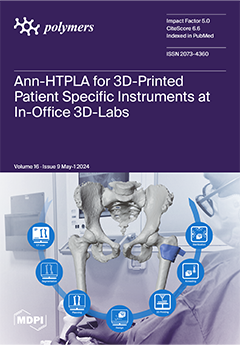The last few decades have witnessed significant advances in the development of polymeric-based foam materials. These materials find several practical applications in our daily lives due to their characteristic properties such as low density, thermal insulation, and porosity, which are important in packaging,
[...] Read more.
The last few decades have witnessed significant advances in the development of polymeric-based foam materials. These materials find several practical applications in our daily lives due to their characteristic properties such as low density, thermal insulation, and porosity, which are important in packaging, in building construction, and in biomedical applications, respectively. The first foams with practical applications used polymeric materials of petrochemical origin. However, due to growing environmental concerns, considerable efforts have been made to replace some of these materials with biodegradable polymers. Foam processing has evolved greatly in recent years due to improvements in existing techniques, such as the use of supercritical fluids in extrusion foaming and foam injection moulding, as well as the advent or adaptation of existing techniques to produce foams, as in the case of the combination between additive manufacturing and foam technology. The use of supercritical CO
2 is especially advantageous in the production of porous structures for biomedical applications, as CO
2 is chemically inert and non-toxic; in addition, it allows for an easy tailoring of the pore structure through processing conditions. Biodegradable polymeric materials, despite their enormous advantages over petroleum-based materials, present some difficulties regarding their potential use in foaming, such as poor melt strength, slow crystallization rate, poor processability, low service temperature, low toughness, and high brittleness, which limits their field of application. Several strategies were developed to improve the melt strength, including the change in monomer composition and the use of chemical modifiers and chain extenders to extend the chain length or create a branched molecular structure, to increase the molecular weight and the viscosity of the polymer. The use of additives or fillers is also commonly used, as fillers can improve crystallization kinetics by acting as crystal-nucleating agents. Alternatively, biodegradable polymers can be blended with other biodegradable polymers to combine certain properties and to counteract certain limitations. This work therefore aims to provide the latest advances regarding the foaming of biodegradable polymers. It covers the main foaming techniques and their advances and reviews the uses of biodegradable polymers in foaming, focusing on the chemical changes of polymers that improve their foaming ability. Finally, the challenges as well as the main opportunities presented reinforce the market potential of the biodegradable polymer foam materials.
Full article






